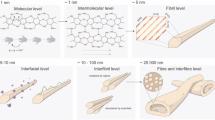Abstract
Acid-catalyzed hydrolysis is controlled not only by temperature and acid concentration but also by the physical state of the cellulose. Under low temperature and acid condition the cellulose structure stays in stable crystalline form. Therefore, the prevailing reaction mode is endwise hydrolysis. Glucose then becomes the main sugar product. However, when temperature and/or acid concentration is raised to a certain level, the cellulose structure becomes unstable by breakage of hydrogen bonding, the primary force that holds the cellulose chains. Once the crystalline structure of the cellulose is disrupted, acid molecules can penetrate into the inner layers of the cellulose chains. In support of this hypothesis, we have experimentally verified that a substantial amount of oligomers is formed as reaction intermediates under extremely low-acid and high-temperature conditions. We also found that the breakage of hydrogen bonds occurs rather abruptly in response to temperature. One such condition is 210°C, 0.07% H2SO4. Glucose, once it is formed in the hydrolysate, interacts with acid-soluble lignin, forming a lignin-carbohydrate complex. This occurs concurrently with other reactions involving glucose such as decomposition and reversion. On the basis of these findings, a comprehensive kinetic model is proposed. This model is in full compliance with our recent experimental data obtained under a broad range of reaction conditions.
Similar content being viewed by others
References
Saeman, J. F. (1945), Ind. Eng. Chem. 37, 43–52.
Springer, E. L. (1966), Tappi 49, 102–106.
Daruwalla, E. H. and Shet, R. T. (1962), Text. Res. J. 32, 942–954.
Nelson, M. L. (1960), J. Polym. Sci. 43, 351–371.
Philipp, B., Jacopian, V., Loth, F., Hirte, W., and Schulz, G. (1979), in Hydrolysis of Cellulose: Mechanisms of Enzymatic and Acid Catalysis, Advances in Chemistry Series, vol. 181, Brown, R. D., Jr. and Jurasek, L., eds., American Chemical Society, Washington, DC, pp. 127–143.
Millett, M. A., Effland, M. J., and Caulfield, D. F. (1979), in Hydrolysis of Cellulose: Mechanisms of Enzymatic and Acid Catalysis, Advances in Chemistry Series, vol. 181, Brown, R. D., Jr. and Jurasek, L., eds., American Chemical Society, Washington, DC, pp. 71–89.
Conner, A. H., Wood, B. F., Hill, C. G., and Harris, J. F. (1986), in Cellulose: Structure, Modification and Hydrolysis, Young, R. A. and Rowell, R. M., eds., J. Wiley & Sons, New York, NY, pp. 281–296.
Bouchard, J., Abatzoglou, N., Chornet, E., and Overend, R. P. (1989), Wood Sci. Technol. 23, 343–355.
Mok, W. S., Antal, M. J., and Varhegyi, G. (1992), I & EC 31, 94–100.
Kim, S. B. and Lee, Y. Y. (1987), Biotech. Bioeng. Symp. 17, 71–84.
Abatzoglou, N., Bouchard, J., Chornet, E., and Overend, R. P. (1986), Can. J. Chem. Eng. 64, 781–786.
Torget, R. W., Kim, J. S., and Lee, Y. Y. (2000), Ind. Eng. Chem. Res. 39, 2817–2825.
Ehrman, T., Ruiz, R., and Templeton, D. (1995), NREL Chemical Analysis & Testing Standard Procedure, LAP No. 002-05, No. 10, National Renewable Energy Laboratory, Boulder, CO.
Torget, R. W., Nagel, N., Jennings, E., Ibsen K., and Elander, R. (1999), presented at 21st Symposium on Biotechnology for Fuels and Chemicals, Fort Collins, CO.
Xiang, Q., Pettersson, P., Torget, R. W., and Lee, Y. Y. (2002), presented at 24th Symposium on Biotechnology for Fuels and Chemicals, Gatlinburg, TN.
Lazareva, T. G. and Vashuk, V. (1996), Int. J. Mod. Phys. 10(23/24), 2983.
Heiner, P. A. and Teleman, O. (1997), Langumir 13(3), 511–518.
Knodo, T. J. (1997), Polymer Sci. 35, 717–723.
Sasaki, M., Kabyemela, B., Adschiri, T., Malahuan, R., Hirose, S., Takeda, N., and Arai, K. (1997), presented at 4th International Symposium on Supercritical Fluids, Sendai, Japan.
Sasaki, M., Fang, Z., Fukushima, Y., Adschiri, T., and Arai, K. (2000), Ind. Eng. Chem. Res. 39, 2883–2890.
Fengel, D. and Wegener, G. (1984), in Wood Chemistry, Ultrastructure, Reactions, Walter de Gruyter, Berlin, pp. 279–281.
Author information
Authors and Affiliations
Corresponding author
Rights and permissions
About this article
Cite this article
Xiang, Q., Kim, J.S. & Lee, Y.Y. A comprehensive kinetic model for dilute-acid hydrolysis of cellulose. Appl Biochem Biotechnol 106, 337–352 (2003). https://doi.org/10.1385/ABAB:106:1-3:337
Issue Date:
DOI: https://doi.org/10.1385/ABAB:106:1-3:337




